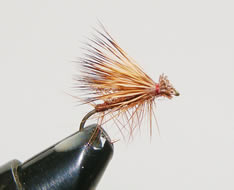Dry Fly Fishing
by
Gene Macri
Dry Fly fishing is what most fly anglers dream of when contemplating fly fishing. But most fly anglers lack good
dry fly technique and methods. Dry flies with massive trout rising to them is what most fly anglers would consider
a good day stream side. Dry Fly fishing unfortunately is not as good as it once was on most trout streams because
of the declining populations of insects due to environmental degradation of our streams.

Adams Dry Fly
Nonetheless, dry fly fisherman must actually be better to "rise a trout" than in yesteryear. Too many fly
anglers just believe they only need to toss the fly out there and a trout will take it. They are often surprised
that the trout won't rise even in shallow water.
One of the things that most fly anglers need to understand is that on some streams the rise takes too much
energy from the trout especially if that trout can just intercept a drifting insect. I don't want you to get
carried away with the energetics of why fish feed because it's already been taken too far by some people in the fly
fishing and they have fly anglers believe all trout feed efficiently and the trout have little energy computers in
their head. This is a bunch of nonsense to say the least.

Caddis Dry Fly
Trout are like people. Some are smart and some are dumb. Some feed efficiently all the time, some most of the
time and some, well not very efficiently. Furthermore, fishing pressure and environmental conditions are serious
influences on how a trout will feed which is often lacking in the analysis by these so called experts.
Trout are brilliant creatures however, they are often curious and sometimes reckless. Because of these traits
they can often be brought to the surface even when there is little or no insect activity. Dry fly fishing is a
matter of getting a fly over a fish without drag and without spooking the fish. This is the normal way of doing it.
When a hatch is on especially a large hatch trout can become reckless (at least some of them). Here are my
recommendations for equipment, techniques and methods for dry fly fishing:
Use a longer rod. I like a 8.6 to 9.0 foot rods. Why? They give you more reach and control over the line which
allows greater control over the drift. Also, they move the line quicker and make it easier cast with fewer false
casts.
Do not use knotted leaders. On some streams even braided butt sections of the leader will spray water and spook
selective trout (especially on spring creeks). The fewer knots in the leader the better because they will cause
drag and catch algae, sticks and other junk floating in the stream.
In most instances try fishing upstream. Most of the time trout will face into the current (not all of the time
but most of the time).
Do not throw out too much line. If you are using a 9 foot rod with a 9 or 10 foot leader and you have 10 to 12 feet
of line out you have around 30 feet of reach. Get as close to the trout as you can without spooking them.
Don't false cast too much because the trout can see the line in the mirror of the stream. Keep you movements and
casting to a minimum.
In reality you are fishing the tippet. So if you have around 40 inches of tippet think of this as your maximum
distance of drift. Don't try and drift a fly more than a few feet over a trout. It usually doesn't work.
Practice your casting and become accurate. This is especially true on spring creeks and tougher streams. You must
be able to put the fly where it needs to be (the best practical fly caster in the world is Lefty Kreh, a friend of
mine and I highly recommend his casting videos and books).
Always use the heaviest tippet you can get away with. Don't use a 7x when a 5x will do. I've seen too many fly
anglers almost kill a small fish because they thought it would break the leader.
Pay careful attention to the surface of the water and make sure you identify to the best of your ability whether a
trout is feeding on the dun, spinner or emerger (try the binoculars).
Like anything good this stuff doesn't come that easy. However, once you condition yourself to these ideas and
techniques you'll catch more fish.
| 
